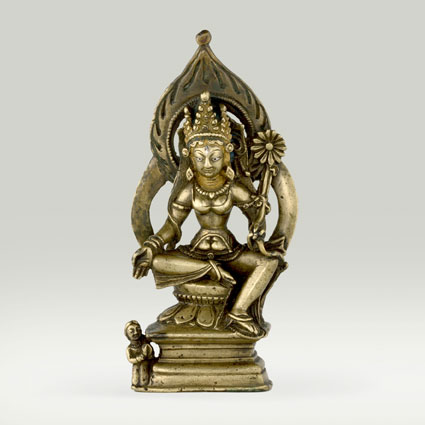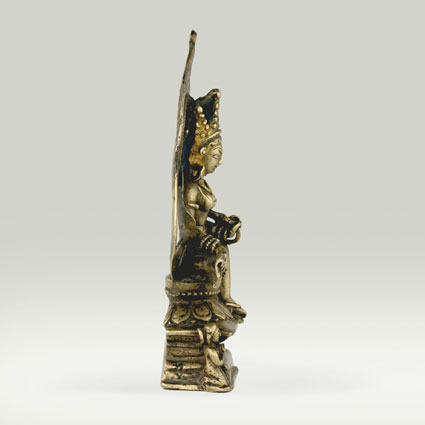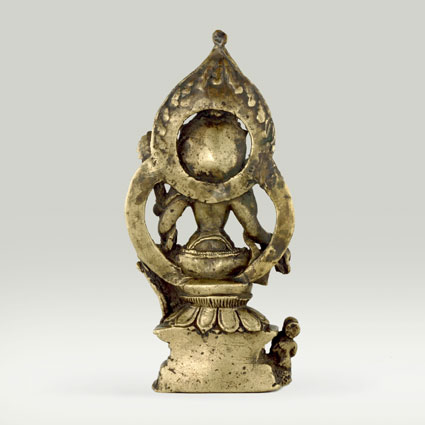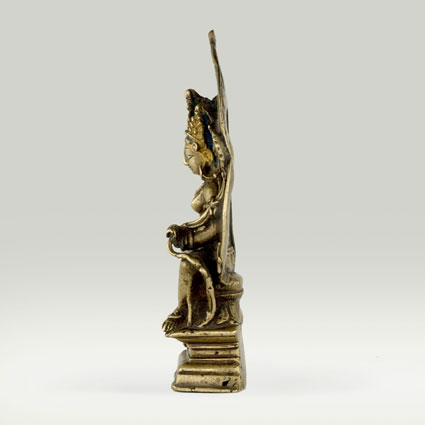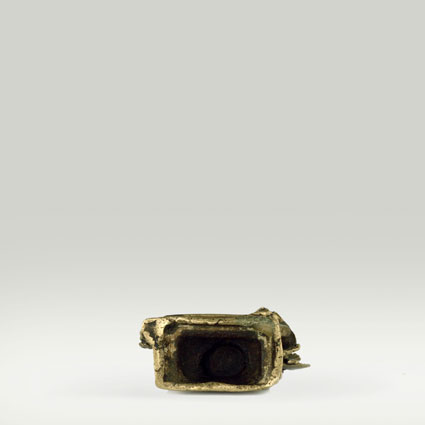ABS 125
Code: ABS 125
Country: India (north-west)
Style: Kashmir Region
Date: 1000 - 1100
Dimensions in cm WxHxD: 5.9 x 14.4 x 3.2
Materials: Brass
(Tib. sGrol ljang)
Cast in one piece, partly hollow.
Face retains remains of painted gold.
The bottom of the pedestal is not sealed.
This image likely represents Syama-Tara (Tib. sGrol Ljang), a form of the "green Tara". She is seated in the attitude of ease with the left leg hanging down (vamudha-paryankasana) on a circular single lotus base placed on a rectangular, stepped pedestal. The goddess holds the right hand in the gesture of charity (varada-mudra); the left hand is raised holding the stalk of a flower blossoming above the left shoulder wich, according to the sadhanas, is a blue lily (nilotpala). The Tara is clad in cloth tied around her hips leaving her stomach bare. She has bejewelled ornaments, namely a three-pointed crown, a pair of romboid earrings, a beaded necklaces, bracelets on the upper arms and wrists, and anklets. The image is encircled by an aurole with the head set against a pointed nimbus decorated with rays. Note the small of the donor kneeling in adoration beside the pedestal.
Tara or Arya Tara, also known as Jetsun Dolma in Tibetan, is a female Buddha typically associated with Buddhist tantra practice as preserved in Tibetan Buddhism. She is the "mother of liberation” and represents the virtues of success in work and achievements. Tara is a tantric deity whose practice is used by practitioners of the Tibetan branch of Vajrayana Buddhism to develop certain inner qualities and understand outer, inner and secret teachings about compassion and emptiness. Tara is not found in the Japanese branch of Vajrayana Buddhism, Shingon.
Tara is actually the generic name for a set of Buddhas or bodhisattvas of similar aspect. These may more properly be understood as different aspects of the same quality, as bodhisattvas are often considered metaphoric for Buddhist virtues.
The most widely known forms of Tara are:
* Green Tara, known as the Buddha of enlightened activity
* White Tara, also known for compassion, long life, healing and serenity; also known as The Wish-fulfilling Wheel, or Cintachakra
* Red Tara, of fierce aspect associated with magnetizing all good things
* Black Tara, associated with power
* Yellow Tara, associated with wealth and prosperity
* Blue Tara, associated with transmutation of anger
* Cittamani Tara, a form of Tara widely practiced at the level of Highest Yoga Tantra in the Gelug School of Tibetan Buddhism, portrayed as green and often conflated with Green Tara
* Khadiravani Tara (Tara of the teak forest), who appeared to Nagarjuna in the Khadiravani forest of South India and who is sometimes referred to as the "22nd Tara."
There is also recognition in some schools of Buddhism of twenty-one Taras. A practice text entitled "In Praise of the 21 Taras", is recited during the morning in all four sects of Tibetan Buddhism.
The main Tara mantra is oṃtare tuttare ture svaha(pronounced by Tibetans and Buddhists who follow the Tibetan traditions as oṃtare tu tare ture soha).
Emergence of Tara as a Buddhist deity
Within Tibetan Buddhism Tara is regarded as a Boddhisattva of compassion and action. She is the female aspect of Avalokitesvara (Chenrezig) and in some origin stories she comes from his tears:
Then at last Avalokiteshvara arrived at the summit of Marpori, the “Red Hill”, in Lhasa. Gazing out, he perceived that the lake on Otang, the “Plain of Milk”, resembled the Hell of Ceaseless Torment. Myriads of being were undergoing the agonies of boiling, burning, hunger, thirst, yet they never perished, but let forth hideous cries of anguish all the while. When Avalokiteshvara saw this, tears sprang to his eyes. A teardrop from his right eye fell to the plain and became the reverend Bhrikuti, who declared: “Son of your race! As you are striving for the sake of sentient beings in the Land of Snows, intercede in their suffering, and I shall be your companion in this endeavour!” Bhrikuti was then reabsorbed into Avalokiteshvara's right eye and was reborn in a later life as the Nepalese princess Tritsun. A teardrop from his left eye fell upon the plain and became the reverend Tara. She also declared, “Son of your race! As you are striving for the sake of sentient beings in the Land of Snows, intercede in their suffering, and I shall be your companion in this endeavour!” Tara was also reabsorbed into Avalokiteshvara's left eye and was reborn in a later life as the Chinese princess Kongjo (Princess Wencheng)."
Tara: From Hinduism to Buddhism
Tara is also known as a saviouress, as a heavenly deity who hears the cries of beings experiencing misery in samsara.
The Tara figure originated not in Buddhism but in Hinduism, where she, Tara, was one of a number of Mother Goddess figures, alongside Sarasvati, Lakshmi, Parvati, and Shakti. In the 6th century C.E., during the era of the Pala Empire, Tara was adopted into the Buddhist pantheon as an important bodhisattva figure just a few centuries after the Prajnaparamita Sutra had been introduced into what was becoming the Mahayana Buddhism of India. It would seem that the feminine principle makes its first appearance in Buddhism as the "Mother of Perfected Wisdom" and then later Tara comes to be seen as an expression of the compassion of perfected wisdom. However, sometimes Tara is also known as "the Mother of the Buddhas", which usually refers to the enlightened wisdom of the Buddhas, so in approaching Buddhist deities, one learns not to impose totally strict boundaries about what one deity covers, as opposed to another deity.
They all can be seen as expressions of the play of the energies of manifested form dancing out of vast emptiness. Be that as it may, Tara began to be associated with the motherly qualities of compassion and mercy. Undoubtedly for the common folk who were Buddhists in India of that time, Tara was a more approachable deity. It is one thing to stare into the eyes of a deity who represents wisdom as void. It is perhaps easier to worship a goddess whose eyes look out with infinite compassion and who has a sweet smile.
Tara then became very popular as an object of worship and was becoming an object of Tantric worship and practice by the 7th century C.E. With the movement and cross-pollination of Indian Buddhism into Tibet, the worship and practices of Tara became incorporated into Tibetan Buddhism. Independent of whether she is classified as a deity, a Buddha or a bodhisattva, Tara remains very popular in Tibet and Mongolia. And as Ms. Getty notes, one other reason for her popularity was that Tara became to be known as a Buddhist deity who could be appealed to directly by lay folk without the necessity or intervention of a lama or monk. Thus, as Tara was accepted into the ranks of Buddhist bodhisattvas, she became popular to both common folks as one to appeal to in daily life, and for monastics, as an entry way into understanding compassion and mercy as part of one's evolving path within Buddhism. (See also Guan Yin, the female aspect of Avalokitesvara in Chinese Buddhism.)
Origin as a Buddhist bodhisattva
Tara has many stories told which explain her origin as a bodhisattva. One in particular has a lot of resonance for women interested in Buddhism and quite likely for those delving into early 21st century feminism.
In this tale there is a young princess who lives in a different world system, millions of years in the past. Her name is Yeshe Dawa, which means "Moon of Primordial Awareness". For quite a number of aeons she makes offerings to the Buddha of that world system "Tonyo Drupa". She receives special instruction from him concerning bodhicitta — the heart-mind of a bodhisattva. After doing this, some monks approach her and suggest that because of her level of attainment she should next pray to be reborn as a male to progress further. At this point she lets the monks know in no uncertain terms that from the point of view of Enlightenment it is only "weak minded worldlings" who see gender as a barrier to attaining enlightenment. She sadly notes there have been few who wish to work for the welfare of beings in a female form though. Therefore, she resolves to always be reborn as a female bodhisattva, until samsara is no more. She then stays in a palace in a state of meditation for some ten million years, and the power of this practice releases tens of millions of beings from suffering. As a result of this Tonyo Drupa tells her she will henceforth manifest supreme bodhi as the Goddess Tara in many world systems to come.
With this story in mind it is interesting to juxtapose this with a quotation from H.H the Dalai Lama about Tara, spoken at a conference on Compassionate Action in Newport Beach, CA in 1989: "There is a true feminist movement in Buddhism that relates to the goddess Tara. Following her cultivation of bodhicitta, the bodhisattva's motivation, she looked upon the situation of those striving towards full awakening and she felt that there were too few people who attained Buddhahood as women. So she vowed: "I have developed bodhicitta as a woman. For all my lifetimes along the path I vow to be born as a woman, and in my final lifetime when I attain Buddhahood, then, too, I will be a woman."
Tara then, embodies certain ideals which make her attractive to women practitioners, and her emergence as a Bodhisattva can be seen as a part of Mahayana Buddhism's reaching out to women, and becoming more inclusive even in 6th century C.E. India.
Tara as a Saviouress
Tara also embodies many of the qualities of feminine principle. She is known as the Mother of Mercy and Compassion. She is the source, the female aspect of the universe, which gives birth to warmth, compassion and relief from bad karma as experienced by ordinary beings in cyclic existence. She engenders, nourishes, smiles at the vitality of creation, and has sympathy for all beings as a mother does for her children.
As Green Tara she offers succor and protection from all the unfortunate circumstances one can encounter within the samsaric world.
As White Tara she expresses maternal compassion and offers healing to beings who are hurt or wounded, either physically or psychically.
As Red Tara she teaches Discriminating Awareness about created phenomena, and how to turn raw desire into compassion and love.
As Blue Tara (Ekajati) she becomes a protector in the Nyingma lineage, who expresses a ferocious, wrathful, female energy whose invocation destroys all Dharmic obstacles and engenders good luck and swift spiritual awakening.
In all within Tibetan Buddhism she has 21 major forms, each tied to a certain colour and energy. And each offers some feminine attribute, of ultimate benefit to the spiritual aspirant who asks for her assistance.
Another quality of feminine principle which she shares with the dakinis is playfulness. As John Blofeld expands upon in Bodhisattva of Compassion, Tara is frequently depicted as a young sixteen-year-old girlish woman. She often manifests in the lives of dharma practitioners when they take themselves, or spiritual path too seriously. There are Tibetan tales in which she laughs at self-righteousness or plays pranks on those who lack reverence for the feminine. In Magic Dance: The Display of the Self-Nature of the Five Wisdom Dakinis, Thinley Norbu explores this as "Playmind". Applied to Tara one could say that her playful mind can relieve ordinary minds which become rigidly serious or tightly gripped by dualistic distinctions. She takes delight in an open mind and a receptive heart then. For in this openness and receptivity her blessings can naturally unfold and her energies can quicken the aspirants spiritual development.
These qualities of feminine principle then, found an expression in Indian Mahayana Buddhism and the emerging Vajrayana of Tibet, as the many forms of Tara, as dakinis, as Prajnaparamita, and as many other local and specialized feminine divinities. As the worship of Tara developed, various prayers, chants and mantras became associated with her. These came out of a felt devotional need, and from her inspiration causing spiritual masters to compose and set down sadhanas, or tantric meditation practices. Two ways of approach to her began to emerge. In one common folk and lay practitioners would simply directly appeal to her to ease some of the travails of worldly life. In the second, she became a Tantric deity whose practice would be used by monks or tantric yogis in order to develop her qualities in themselves, ultimately leading through her to the source of her qualities, which are Enlightenment, Enlightened Compassion, and Enlightened Mind.
Tara as a Tantric deity
Tara as a focus for tantric deity yoga can be traced back to the time period of Padmasambhava. There is a Red Tara practice which was given by Padmasambhava to Yeshe Tsogyal. He asked that she hide it as a treasure. It was not until this century, that a great Nyingma lama, Apong Terton rediscovered it. This lama was reborn as His Holiness Sakya Trizin, present head of the Sakyapa sect. A monk who had known Apong Terton succeeded in retransmitting it to H.H. Sakya Trizin, and the same monk also gave it to Chagdud Tulku Rinpoche, who released it to his western students.
Martin Willson in In Praise of Taratraces many different lineages of Tara Tantras, that is Tara scriptures used as Tantric sadhanas. For example, a Tara sadhana was revealed to Tilopa, (988-1069 C.E.) the human father of the Karma Kagyu. Atisa, the great translator and founder of the Kadampa school of Tibetan Buddhism, was a devotee of Tara. He composed a praise to her, and three Tara Sadhanas. Martin Willson's work also contains charts which show origins of her tantras in various lineages, but suffice to say that Tara as a tantric practice quickly spread from around the 7th century C.E. onwards, and remains an important part of Vajrayana Buddhism to this day.
The practices themselves usually present Tara as a tutelary deity (thug dam, yidam) which the practitioners sees as being a latent aspect of one's mind, or a manifestation in a visible form of a quality stemming from Buddha Jnana. As John Blofeld puts it in his The Tantric Mysticism of Tibet: “The function of the Yidam is one of the profound mysteries of the Vajrayana... Especially during the first years of practice the Yidam is of immense importance. Yidam is the Tibetan rendering of the Sanskrit word "Istadeva" – the in-dwelling deity; but, where the Hindus take the Istadeva for an actual deity who has been invited to dwell in the devotee's heart, the Yidams of Tantric Buddhism are in fact the emanations of the adepts own mind. Or are they?
To some extent they seem to belong to that order of phenomena which in Jungian terms are called archetypes and are therefore the common property of the entire human race. Even among Tantric Buddhists, there may be a division of opinion as to how far the Yidams are the creations of individual minds. What is quite certain is that they are not independently existing gods and goddesses; and yet, paradoxically, there are many occasions when they must be so regarded.”
Sadhanas of Tara
Sadhanas in which Tara is the yidam (meditational deity) can be extensive or quite brief. Most all of them include some introductory praises or homages to invoke her presence and prayers of taking refuge. Then her mantra is recited, followed by a visualization of her, perhaps more mantra, then the visualization is dissolved, followed by a dedication of the merit from doing the practice. Additionally, there may be extra prayers of aspirations, and a long-life prayer for the Lama who originated the practice. Many of the Tara sadhanas are seen as beginning practices within the world of Vajrayana Buddhism, however what is taking place during the visualization of the deity actually invokes some of the most sublime teachings of all Buddhism.
In this case during the creation phase of Tara as a yidam, she is seen as having as much reality as any other phenomena apprehended through the mind. By reciting her mantra and visualizing her form in front, or on the head of the adept, one is opening to her energies of compassion and wisdom. After a period of time the practitioner shares in some of these qualities, becomes imbued with her being and all it represents. At the same time all of this is seen as coming out of Emptiness and having a translucent quality like a rainbow. Then many times there is a visualization of oneself as Tara. One simultaneously becomes inseparable from all her good qualities while at the same time realizing the emptiness of the visualization of oneself as the yidam and also the emptiness of one's ordinary self.
This occurs in the completion stage of the practice. One dissolves the created deity form and at the same time also realizes how much of what we call the "self" is a creation of the mind and has no long term substantial inherent existence. This part of the practice then is preparing the practitioner to be able to confront the dissolution of one's self at death and ultimately be able to approach through various stages of meditation upon emptiness, the realization of Ultimate Truth as a vast display of Emptiness and Luminosity. At the same time the recitation of the mantra has been invoking Tara's energy through its Sanskrit seed syllables and this purifies and activates certain psychic centers of the body (chakras). This also untangles knots of psychic energy which have hindered the practitioner from developing a Vajra body, which is necessary to be able to progress to more advanced practices and deeper stages of realization.
Therefore even in a simple Tara sadhana a plethora of outer, inner, and secret events is taking place and there are now many works such as Deity Yoga, compiled by the present Dalai Lama, which explores all the ramifications of working with a yidam in Tantric practices.
The end results of doing such Tara practices are many. For one thing it reduces the forces of delusion in the forms of negative karma, sickness, afflictions ofkleshas, and other obstacles and obscurations. The mantra helps generate Bodhicitta within the heart of the practitioner and purifies the psychic channels (nadis) within the body allowing a more natural expression of generosity and compassion to flow from the heart center. Through experiencing Tara's perfected form, one acknowledges one's own perfected form, that is one's intrinsic Buddha nature, which is usually covered over by obscurations and clinging to dualistic phenomena as being inherently real and permanent.
The practice then weans one away from a coarse understanding of Reality, allowing one to get in touch with inner qualities similar to those of a bodhisattva, and prepares one's inner self to embrace finer spiritual energies, which can lead to more subtle and profound realizations of the Emptiness of phenomena and self.
As Chagdud Tulku Rinpoche, in his Introduction to the Red Tara Sadhana, notes of his lineage: "Tara is the flawless expression of the inseparability of emptiness, awareness and compassion. Just as you use a mirror to see your face, Tara meditation is a means of seeing the true face of your mind, devoid of any trace of delusion".
Terma teachings related to Tara
Jamyang Khyentse Wangpo discovered Phagme Nyingthig (Tib. spelling: 'chi med 'phags ma'i snying thig, Innermost Essence teachings of the Immortal Bodhisattva [Arya Tara]).
Earlier in the 19th century, according to a biography, Nyala Pema Dündul received a Hidden Treasure Tara Teaching and Nyingthig (Tib. nying thig) from his uncle Kunsang Dudjom (Tib. kun bzang bdud 'joms). It is not clear from the source whether the terma teaching and the nyingthig teachings refer to the same text or to two different texts.
Arènes, Pierre, 1996. La déesse sGrol-ma (Tara). Leuven: Uitgeverij Peeters en Departement Oriëntalistiek. References to the iconography of Tara
Beyer, Stephan, 1978. The Cult of the Tara - Magic and Ritual in Tibet. Berkeley: University of California Press. References to the iconography of Tara
Bhattacharyya, Benoytosh , 1958. Indian Buddhist Iconography. Calcutta: K. L. Mukhopadhyay. Pp. 128–29, 131, 135, 189–90, 226–32, 240–43, 249–50, 306–9 - References to the iconography of Tara
Bokar Rimpoché, 2005. Tara l'éveil au féminin. Claire Lumiere. Pp. 23-33, /50-56 - References to the iconography of Tara
de Mallmann, Marie-Thérèse, 1975. Introduction à l'iconographie du tântrisme bouddhique. Paris: Adrien Mainsonneuve (Jean Maisonneuve successeur (1970). Pp. 369–370 - References to the iconography the “green Tara”
de Mallmann, Marie-Thérèse, 1975. Introduction à l'iconographie du tântrisme bouddhique. Paris: Adrien Mainsonneuve (Jean Maisonneuve successeur (1970). Pp. 368-379 - References to the iconography of Tara
Gosh, Mallar, 1980. Development of Buddhist Iconography in Eastern India: A Study of Tara, Prajnas of Five Tathagatas and Bhrikuti. New Dehli: Hard Bound English Munshiram Manoharlal Publishers (P) Ltd. References to the iconography of Tara
Kumar, Pushpendra, 1992. Tara, the Supreme Goddess. Delhi: Bharatiya Vidya Prakashan. References to the iconography of Tara
Sèngué, Tcheuky, 2002. Petite Encyclopédie des Divinités et symboles du Bouddhisme Tibétain. Editions Claire Lumiere . Pp. 240-241 - References to the iconography of Tara
von Schroeder, Ulrich, 2010. Buddhist Sculptures of the Alain Bordier Foundation. Hong Kong: Visual Dharma Publications, Ltd.. Pp. 14–15; plate 4B
Wilson, Martin, 1986. In Praise of Tara: Songs to the Saviouress. London: Wisdom Publ. References to the iconography of Tara

